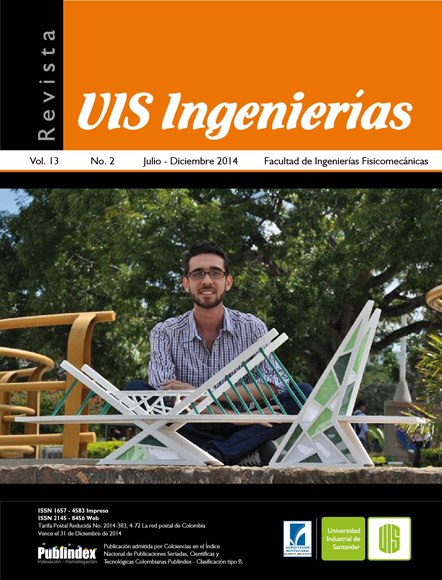Articles
Bases for reliability analysis of disrupted materials flows
Published 2014-02-03
Keywords
- slope stability,
- disrupted material flows,
- reliability analysis
How to Cite
Trujillo-Vela, M. G., & Ramos-Cañón, A. M. (2014). Bases for reliability analysis of disrupted materials flows. Revista UIS Ingenierías, 13(2), 29–38. Retrieved from https://revistas.uis.edu.co/index.php/revistauisingenierias/article/view/29-38
Abstract
As an alternative to conventional methods for slope stability analysis using limit equilibrium theory, this paper uses a method to simulate material flows disrupted arising from the continuum mechanics (Eulerian perspective),conservation mass and momentum, proposed by Iverson and Denlinger (2001a). This procedure involves the behavior of a mixture of solid and Newtonian fluid whose interaction is represented by frictional resistance law of Coulomb. The momentum equation is simplified for an idealized case in order to obtain an analytical solution to generate the velocity and displacement of the center of mass. This type of approach allows taking into account the mode of deformation observed in field, unlike conventional methods based on equilibrium limit (slices – infinite slope), where the assumption is rigid body motion. The analytical solution is used as the basis for estimate the exposure of infrastructure within the framework of analysis based on reliability. The results show how varies the conditional probability of occurrence of a velocity depending on the distance of the source material.Downloads
References
- ABKOWITZ, F. EIGER, A. SCHMIDT, B. T., JOHNSON, P. (1988). “Geotechnical Engineering”. Geotechnical Science 17(1): 450-465.
- ANG, A. H.-S., TANG, W. H, 2007. Probability concepts in engineering: emphasis on applications in civil & environmental engineering. segunda ed. New York: Wiley.
- BAECHER, G. B., CHRISTIAN, J, 2003. Reliability and statistics in geotechnical engineering. segunda ed. New York: J. Wiley
- DAS, B. M., 2001. Fundamentos de Ingeniería y Geotécnica. México D.F.: Thomson Editores S.A.
- DENLINGER, R.P. Iverson, R.M., 2001. Flow of Variably Fluidized Granular Masses Across ThreeDimensional Terrain 2. Numerical Predictions and Experimental Test. Reviews of Geophysics, 106, pp.553-66.
- IDEAM, 2012. Instituto de hidrología, meteorología y estudios ambientales. [Online] Available at: http:// www.pronosticosyalertas.gov.co/jsp/loader.jsf?lServic io=Publicaciones&lTipo=publicaciones&lFuncion=lo adContenidoPublicacion&id=895 [Accessed 7 Marzo 2012].
- IVERSON, R. M., 1997. The physics of debris flows. Reviews of Geophysics, August, 35(3), pp. 245-296.
- IVERSON, R.M., 2005. Debris-flow mechanics. In Jakob, M. y Hungr, O. Debris-flow hazards and related phenomena. Berlin, Heidelberg, Alemania: Springer Berlin Heidelberg. Ch. 6. pp.105-34.
- IVERSON, R.M. y Denlinger, R.P., 2001. Flow of variably fluidized granular masses across threedimensional terrain 1. Coulomb mixture theory. Journal of Geophysical Research, 106(B1), pp.537-52.
- PERÁLVAREZ, J. et al. 2008. Análisis de susceptibilidad a los movimientos de ladera mediante un SIG en la cuenca vertiente al embalse de Rules, Granada. In Conferencia ESRI España 2008. Madrid, 2008.
- PUDASAINI, S; WANG, Y; Hutter, K. 2005. Modelling Debris Flows Down General Channels. Natural Hazards and Earth System Sciences, 5, pp.799-819.
- QUAN L. et al., 2012. Analysis of Debris Flows Behavior with a one Dimensional run-out Model Incorporating Entrainment. Engineering Geology, 128, pp.63-75.
- RICKENMANN,D; LAIGLE, D.M.B.W. y Hübl, J., 2006. Comparison of 2D Debris-Flow Simulation Models with Field Events. Computational Geosciences, 10(2), pp.241-64.
- ROSENBLUETH, E., 1975. Points estimates for probability moments. Proceedings, National Academy of Science, 23(3), pp.470-72.
- SÁNCHEZ, M., 2010. Introducción a la confiabilidad y evaluación de riesgos: teoría y aplicaciones en ingeniería. segunda ed. Bogotá D.C.: Ediciones Uniandes.
- SHRESTHA, B.B. et al. 2008. Numerical simulation on debris-flow deposition and erosion processes upstream of a check dam with experimental verification. Annual of Disas. Prev. Res. Inst., (51 B), pp.613-23.
- SUAREZ, J; 1998. Deslizaminetos y estabilidad de taludes en zonas tropicales. Bucaramanga, Santader, Colombia: Universidad Industrial de Santander.
- TRUJILLO, M.G., 2012. Modelación matemática para flujos de material desagregado. Trabajo de titulación (Ingeniero Agrícola). Neiva, Colombia: Universidad Surcolombiana y Pontificia Universidad Javeriana.
- TRUJILLO, M; RAMOS, A.M. 2012. Modelo para simulación de flujos de material desagregado. comparación con el método de talud infinito. Enviado a la revista Ciencia e Ingeniería Neogranadina. En evaluación.
- VARGAS, R. 2000. Seminario estudios de riesgos por fenómenos de remoción en masa. Bogotá D.C., Cundinamarca, Colombia: Dirección de Prevención y Atención de Emergencias de Santa Fe De Bogotá.
- WAN, C; LIS, S; ESAKI, T. 2008. GIS-Based TwoDimensional Numerical Simulation of Rainfall-Induced Debris Flow. Natural Hazards and Earth System Sciences, 8, pp.47-58.

